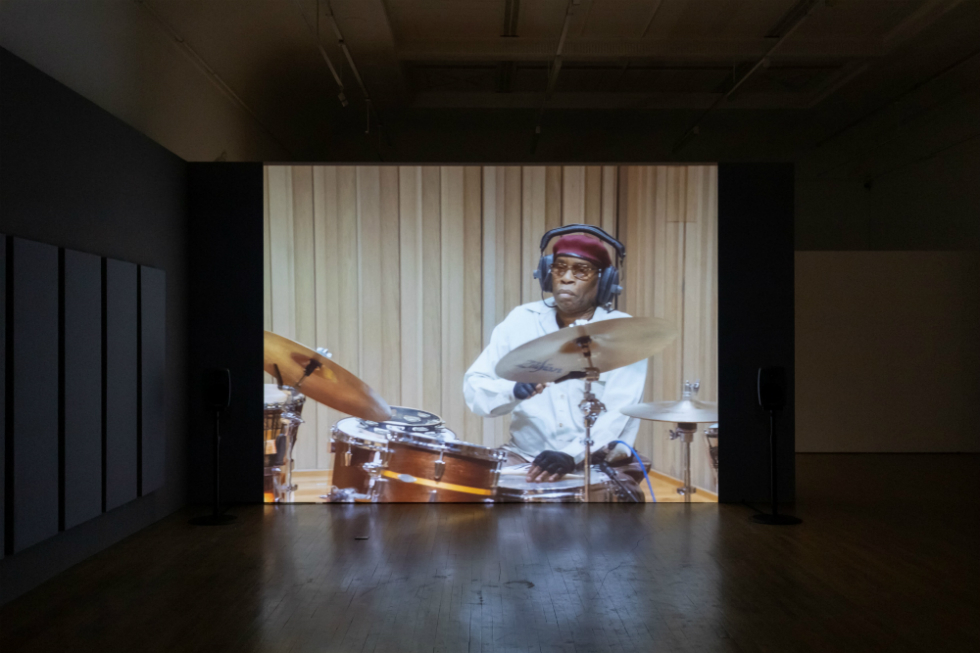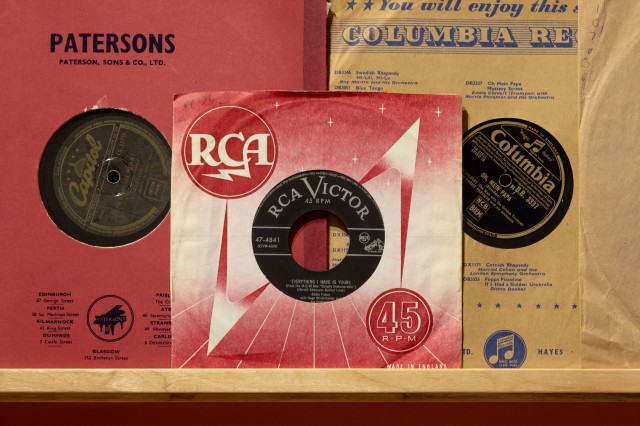What Goes Around Comes Around. Everything I Have Is Yours – Reviewed

Post-internet generations have grown up with access to literally millions of songs. But, asks Angela Tait, what happens to those tracks not yet digitised? She explores a new exhibition whose scope is to address the ownership and availability of pop’s yesteryear…
In a world where we consume sounds with casual immediacy, via such accessible digital platforms as Spotify, iTunes and SoundCloud, what happens to those of our relatively recent history, the soundtracks to our parents’ or grandparents’ youth? The analogue recordings of the mid-20th Century – primarily held on vinyl and shellac – are now falling out of their 50-year copyright agreements. So, where do these sounds now belong, and who to? While vinyl sales are again on an upwards trajectory, is the dawn of popular music to remain within the confines of these nostalgic objects, or can we reclaim them, for a contemporary cultural purpose; to listen, to share, to re-appropriate and to liberate?
Artists Eileen Simpson and Ben White address these questions through their project, Open Music Archive (OMA), in a work currently on display at Salford Museum and Art Gallery. The OMA aims to digitise out of copyright music, and distribute it for free. This is more difficult than it at first sounds when dealing with 1920s jazz, or late Victorian British music hall, which might exist as gramophone records, tucked away in private collections and archives. While the OMA’s endeavour is an admirable one, its value really shines in the reuse and reimagining of otherwise hidden or forgotten works. Their current show – Everything I Have Is Yours – shares its name with a 1933 song by Burton Land and Harold Adamson, but is also deeply suggestive of the aims of the wider project.
Everything I Have Is Yours is a new audio-visual installation using samples from the big hits of the first decade (1952-62) of the music charts. Looped tracks are performed by those involved in the music industry in Manchester and Salford at the time. Now in their 70s and 80s, these musicians, don’t forget, were the original teenagers. We don’t know their identities, or what part exactly they might have played back then, but they were at ground zero of the huge cultural shifts experienced during that post-war decade.
Noting its responsibility to those times, this work is seriously ambitious. Not only have the artists tracked down these performers, but they have also convinced them to play in an experimental artwork. How, we can only speculate. This piece leaves us ample room for that. In line with the overall philosophy of the Open Music Archive, interpretation is handed to us, the listener, the viewer or the consumer. We’re still left with numerous questions: Who are these performers of yesteryear? Were they famous (or on the verge of fame) in their time – would my mother have listened or danced to their songs? Are they removed from the present and relocated within their youth by the process – time travel by way of popular culture? Which specific recordings are being sampled, and: Did any of them hang out with The Beatles?

I view the work from the comfort of a sofa, almost curling my feet beneath my body, before quickly remembering where I am. This pseudo domestic arrangement is somewhat mirrored on screen. We follow a gently rotating camera action surveying the musicians performing samples – snippets if you will – reliving their days as recording artists. Scenery is sparse, walls the same colour as the freestanding acoustic panels, an occasional armchair next to an amp, and drum kits resting on faded patterned rugs. It’s more akin to a living room than a recording studio.
Some of the players in the scenes are vaguely familiar… or are they? During the cyclical narrative, which never really starts or concludes, I start to pick out my favourite ‘characters’. The percussionist with the round glasses pushed up just above his eyebrows, the tongue of concentration enabling him to keep the essential beat which underpins bits of the soundtrack. The ladies, too. Immaculately made up and fashionably dressed, they share identically coloured hair, somewhere between silver grey and platinum blonde, an indicator of both their septuagenarian status and their history as, we might assume, the movers and shakers of the 1950s Manchester music scene.
The sounds switch; a slightly discordant jazz feel of the sax and double bass one minute, a distinctive 1950s pop followed by an orchestral sound with choral voices the next. Again, there’s a recollection, the chord tugs on a memory which I can’t quite place. The circularly performed narrative is punctuated by brief inserts of trappings of the era. Visual signifiers include gloriously 1950s and 60s-looking graphics of record labels and sleeves. Everything I Have Is Yours is a visual and auditory collage of repetition and rhythm which dangles sounds and images tantalisingly in front of you but, like a memory on the tip of your tongue, never fully reveals its hand.
Although billed as ‘A major new moving image and sound artwork exploring the first decade of the music charts’, its scope means that this is, ultimately, a modest assessment. While it relies heavily upon the past for its source material, I would argue for a wider interpretation. It is a project situated firmly in the present through its political intention to make these works universally available to contemporary audiences. In Everything I Have Is Yours, Simpson and White are subtly – yet explicitly – addressing issues of authorship and ownership while playing with nostalgia on both sides of the camera. By using local participants, presented at the Salford Museum and Gallery, the film engages with the social consciousness and history of a city. I urge you to experience this work in situ and give it the time it deserves.
Angela Tait
Everything I Have Is Yours continues @ Salford Museum and Art Gallery until Sunday 3 November
All images installation shots from Everything I have Is Yours, Salford Museum and Art Gallery, courtesy Jules Lister





